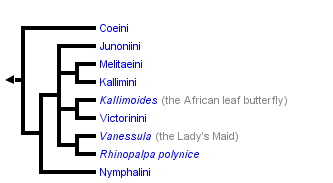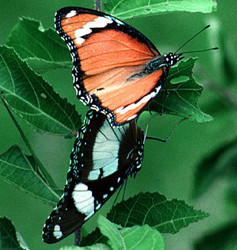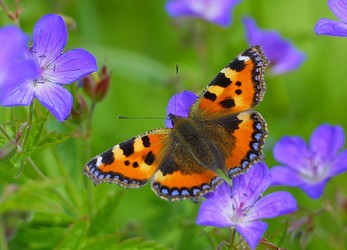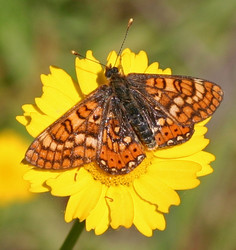Nymphalinae
Niklas Wahlberg and Andrew V. Z. Brower


This tree diagram shows the relationships between several groups of organisms.
The root of the current tree connects the organisms featured in this tree to their containing group and the rest of the Tree of Life. The basal branching point in the tree represents the ancestor of the other groups in the tree. This ancestor diversified over time into several descendent subgroups, which are represented as internal nodes and terminal taxa to the right.

You can click on the root to travel down the Tree of Life all the way to the root of all Life, and you can click on the names of descendent subgroups to travel up the Tree of Life all the way to individual species.
For more information on ToL tree formatting, please see Interpreting the Tree or Classification. To learn more about phylogenetic trees, please visit our Phylogenetic Biology pages.
close boxIntroduction
Nymphalinae comprises about 500 species distributed around the world. Several species in the group have been studied intensively, such as the checkerspots (Euphydryas and Melitaea), buckeyes (Junonia) and comma butterflies (Polygonia). The circumscription of Nymphalinae has enjoyed a dynamic history as various authors have considered various groups of species to represent core nymphalids. The current circumscription was partially suggested by Harvey (1991), with Wahlberg et al. (2005) including Coeini in the subfamily. The host plants of Nymphalinae are mainly in the families Urticaceae, Asteraceae, Acanthaceae, Plantaginaceae and Scrophulariaceae.
Wahlberg (2006) used fossil evidence and molecular data to arrive at an age of about 65 million years for the subfamily (not including Coeini which suffers from long branch problems). This age is surprisingly old (the age of butterflies has long been thought to be about 70 million years), but suggests that the great extinction event at the Cretaceous/Tertiary boundary (best known for the point in time when the dinosaurs went extinct) has had a significant effect on the evolution of butterflies.
References
Harvey, D. J. 1991. Higher classification of the Nymphalidae, Appendix B. Pages 255-273 in The Development and Evolution of Butterfly Wing Patterns (H. F. Nijhout, ed.) Smithsonian Institution Press, Washington DC.
Wahlberg, N. 2006. That awkward age for butterflies: insights from the age of the butterfly subfamily Nymphalinae. Systematic Biology 55:703-714.
Wahlberg, N., A. V. Z. Brower, and S. Nylin. 2005. Phylogenetic relationships and historical biogeography of tribes and genera in the subfamily Nymphalinae (Lepidoptera: Nymphalidae). Biological Journal of the Linnean Society 86:227-251.
Title Illustrations

| Scientific Name | Aglais urticae |
|---|---|
| Location | Switzerland |
| Specimen Condition | Live Specimen |
| Source | Petite tortue |
| Source Collection | Flickr |
| Image Use |
 This media file is licensed under the Creative Commons Attribution-NonCommercial-ShareAlike License - Version 2.0. This media file is licensed under the Creative Commons Attribution-NonCommercial-ShareAlike License - Version 2.0.
|
| Copyright | © 2004 Luciano Giussani |
| Scientific Name | Euphydryas aurinia |
|---|---|
| Specimen Condition | Live Specimen |
| Source | Euphydryas aurinia (Rottemburg, 1775) |
| Source Collection | Flickr |
| Image Use |
 This media file is licensed under the Creative Commons Attribution-NonCommercial-ShareAlike License - Version 2.0. This media file is licensed under the Creative Commons Attribution-NonCommercial-ShareAlike License - Version 2.0.
|
| Copyright | © 2006 Carlos Franquinho |
About This Page
Niklas Wahlberg

University of Turku, Finland

Middle Tennessee State University, Murfreesboro, Tennessee, USA
Correspondence regarding this page should be directed to Niklas Wahlberg at and Andrew V. Z. Brower at
Page copyright © 2009 Niklas Wahlberg and
 Page: Tree of Life
Nymphalinae .
Authored by
Niklas Wahlberg and Andrew V. Z. Brower.
The TEXT of this page is licensed under the
Creative Commons Attribution License - Version 3.0. Note that images and other media
featured on this page are each governed by their own license, and they may or may not be available
for reuse. Click on an image or a media link to access the media data window, which provides the
relevant licensing information. For the general terms and conditions of ToL material reuse and
redistribution, please see the Tree of Life Copyright
Policies.
Page: Tree of Life
Nymphalinae .
Authored by
Niklas Wahlberg and Andrew V. Z. Brower.
The TEXT of this page is licensed under the
Creative Commons Attribution License - Version 3.0. Note that images and other media
featured on this page are each governed by their own license, and they may or may not be available
for reuse. Click on an image or a media link to access the media data window, which provides the
relevant licensing information. For the general terms and conditions of ToL material reuse and
redistribution, please see the Tree of Life Copyright
Policies.
- First online 25 September 2006
Citing this page:
Wahlberg, Niklas and Andrew V. Z. Brower. 2025. Nymphalinae . Version 24 September 2025 (under construction). http://tolweb.org/Nymphalinae/12195/2025.09.24 in The Tree of Life Web Project, http://tolweb.org/











 Go to quick links
Go to quick search
Go to navigation for this section of the ToL site
Go to detailed links for the ToL site
Go to quick links
Go to quick search
Go to navigation for this section of the ToL site
Go to detailed links for the ToL site